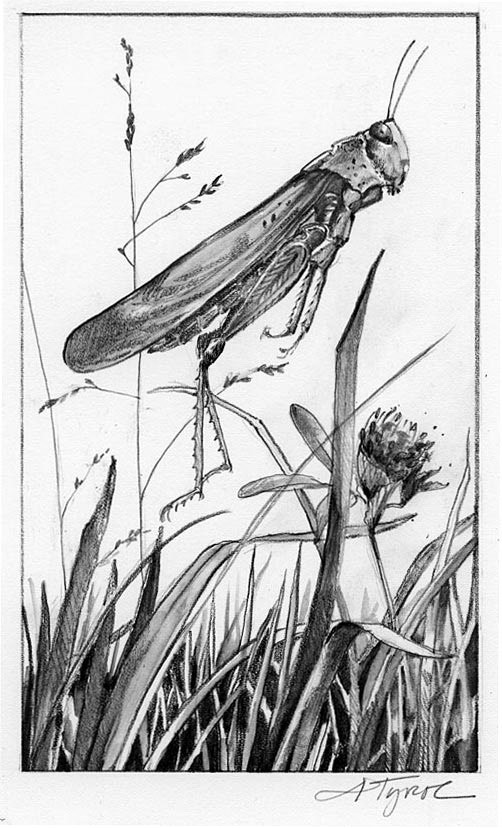
I have a confession to make. Up until a week or so ago, I didn’t know how to tell a grasshopper from a cricket. I’d see some sort of large, hopping insect, reach for my field guide, and – what is that thing? – could not come to a conclusion before it hopped away.
Now I know. It ain’t easy. But more important, I had been approaching it all wrong. I was looking for grasshoppers to be in one group, with understandable grasshopper characteristics. And for crickets to be in another, with cricket characteristics. But it doesn’t work that way.
There are indeed two groups, but they are both grasshoppers. One group is the short-horned grasshoppers, also known as locusts. The “horns” are antennae. In this group, the antennae are shorter than the length of the body, often less than half as long. Short-horns are generally active during the day, so if you see a grasshopper-like insect winging across your yard during daylight hours, it’s most likely a short-horn.
The other group is the long-horned grasshoppers, which includes katydids and crickets. All of these have “horns” or antennae that are longer than their bodies. Crickets fold their wings flat down on their backs, while most of the other long-horned grasshoppers, including katydids, fold them tent-like above their backs. Members of the long-horned club move about and make most of their noise at night, so that insect chirping away under the supper table is apt to be a cricket (or other long-horned cousin).
Ross Bell, a professor emeritus at the University of Vermont, became interested in grasshoppers and crickets about 15 years ago. Not much was known about grasshoppers and crickets in Vermont then, and Bell feels that not all that much more is known about them now. “Grasshoppers don’t sting people, so they don’t get much attention,” he says.
But Bell is keeping count. In Vermont, there are 39 species of short-horned grasshoppers, 16 species of crickets, and 17 other species of long-horned grasshoppers.
In New Hampshire are 35 short-horned grasshopper species, 15 crickets, 16 other species of long-horned grasshoppers, plus 5 camel crickets, a mole cricket, a pygmy mole cricket, and 7 species of pygmy grasshoppers.
As for how the species tell themselves apart, it appears that sound is the main way. Bell says some people who collect crickets don’t even collect their bodies, as most insect collectors do. They just record their songs.
“In some cases, you can’t even tell the cricket species apart if you are holding them in your hand,” Bell says, “but you can tell when they call.”
Around my house at this time of year, the Carolina grasshopper is everywhere, erupting in short, noisy flights across the gravel driveway on its white-banded wings. This is a short-horned grasshopper, most active by day. It’s found in both Vermont and New Hampshire. Bell notes that it is the most common grasshopper in the Connecticut River valley. It can be quite colorful, he says; its wings are black with yellow borders, and a related species has wings that are sometimes yellow or pink.
Long-horned grasshoppers and crickets “sing” by rubbing a “scraper” on one wing against a “file” on the other wing. Some short-horned grasshoppers sing by rubbing a leg against a wing.
The “songs” of other short-horned grasshoppers are mechanical sounding – buzzes, whirrs, and clicks. The song of the house cricket goes cheep-cheep-cheep (pause) cheep-cheep-cheep (pause). The songs of other crickets, katydids, and the other long-horned grasshoppers can be complex, with chirps and buzzes and pauses. If you can hum along, then it’s a cricket, advises one field guide. I’m not convinced that’s entirely true, but it’s a place to start.
Grasshoppers and crickets sing for pretty much the same reason birds do. The males sing to attract females and to stake out their territory. In some species, the females respond to the males with a song of their own.
Bell says it is not a myth: the temperature cricket, a kind of tree cricket, will tell you the temperature in Fahrenheit if you count the number of chirps it makes in 15 seconds and then add 37. However, he adds, all grasshoppers and crickets sing faster when it is warmer and slower when it’s colder. It’s a function of their cold-blooded metabolism. When the weather is hotter, they do everything faster.
Personally, I’ll use a thermometer when I need to know the temperature. But I’m keeping an ear out for the scritches, scratches, chirps, and hums of late summer and early fall. Now that I know that grasshoppers and crickets are easier to tell apart by sound than sight, I’ll be listening more closely.

